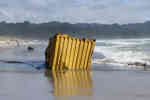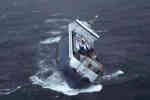Step 2 of 3•4 minutes read
The Consequences of Cargo Shifting Onboard a Ship
The consequences caused by inadequately stowed and secured cargo can be divided into the following categories:
- Bad-will.
- Economic consequences.
- Damage to cargo and ship.
- Damage to the environment.
- Loss of lives.
- Loss of vessel.
These categories are described more thoroughly below.
Bad-will
Inadequately secured cargo that shifts is often damaged beyond repair. Production of a replacement product may take several months and if this leads to a production stop, the costs will run high. Accidents like this will induce bad will, both to the equipment supplier and the shipping company. One type of cargo for which this is very clear is machinery equipment and other heavy products transported on ships for distribution to factories, power plants, and similar industries, often shipped as project cargo in large boxes. Such cargoes can be precious and sensitive to shocks and impacts. As they are often scheduled to be installed at a certain date, the margins for delivery time are narrow, and any delays are costly for all parties involved in the installation process.
Economic Consequences
The RoRo vessel in the below photo experienced a cargo shift in the Irish Sea, which resulted in a significant static heeling angle, threatening to capsize the vessel. The passengers and some crew were airlifted by rescue helicopters while the remaining crew members struggled to save the vessel.
The vessel ended up at the beach and despite efforts to tug her off the ground and get her afloat, the owners were, in the end, forced to scrap the vessel. The economic consequences of the cargo shift on this vessel thus became extremely large.

Cargo shift on a RoRo vessel
Damage to Cargo and Ship
The most obvious consequence of a cargo shift is the risk of damage to the cargo itself, but there are secondary effects that might pose a threat to the safety of the vessel. Loose cargo units that have shifted might block emergency escape routes or cut the lashings for other units, making them loose. Damaged cargo units might leak dangerous substances, possibly resulting in chemical reactions which might injure one's health or cause a fire to break out. Shifting cargo may also damage the internal structure of the vessel or penetrate the hull or tanks.

Cargo shifting may cause damage to the cargo, but also to the vessel
The ship shown in the photo below had a total cargo shift during a North Sea voyage. Most of the cargo was destroyed. Accidents like this one are often very difficult to investigate since such investigations must determine where the cargo began to shift. Whether it was caused by inadequate cargo securing within the units or if it was caused by insufficient arrangements for securing the units to the vessel.

A total cargo shift, destroying most of the cargo
Damage to the Environment
Environmental damage may occur when containers loaded with dangerous goods, such as toxic, poisonous or nuclear substances, are lost overboard. In the same way, wrecked and sunken vessels may contaminate the environment for many years.

Lost goods can contaminate the environment
Loss of Lives and Loss of the Vessel
The RoRo vessel in the picture below was on a voyage from Finland to Denmark when it encountered severe weather conditions with heavy swell coming in from stern to quartering stern. The vessel rolled from side to side a few times and then received a permanent list of about 30 degrees due to shifting of the cargo.
Despite the presence of five helicopters, the rescue force was unable to lift the crew of the vessel while it remained afloat as it was still rolling heavily from side to side. Due to flooding, the vessel subsequently sank, with one crew member followed her into the depths. The remaining crew was rescued from the water by helicopters, but one crew member unfortunately died.
Casualties like these represent the worst possible outcome of a cargo shift.

Shifting cargo can have fatal consequences
Summary
Accidents due to inadequate cargo securing have occurred as long as mankind has transported goods at sea. The invention of RoRo vessels increased the statistics to show that the number of incidents and accidents has increased. The proportion of total breakdowns due to poor cargo securing is a contributing reason for this development.
Besides the risks for people and vessels, there is also the risk of environmental pollution and degraded quality of delivery, which is why it is so important to have proper cargo securing.
The risk of accidents can be minimised if everyone involved in a transport chain is aware of the consequences of inadequate cargo securing and knows how to properly secure their cargo, both inside cargo transport units and on board RoRo vessels.